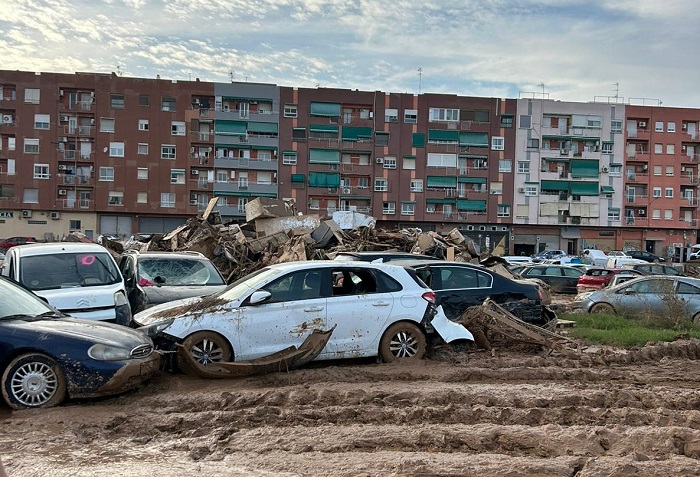Esta web utiliza cookies para que podamos ofrecerte la mejor experiencia de usuario posible. La información de las cookies se almacena en tu navegador y realiza funciones tales como reconocerte cuando vuelves a nuestra web o ayudar a nuestro equipo a comprender qué secciones de la web encuentras más interesantes y útiles.

DANA in Valencia: Heartbreaking figures that tell a sad story
Although there is an abundance of information on the damage caused in Valencia on October 29th of 2024 by the DANA (Spanish acronym for “Depresión Aislada en Niveles Altos”, meaning isolated depression at high levels), it is still impossible to accurately determine the extent of a disaster that has multiple facets and requires a thorough analysis. The more than two hundred people who perished in the floods is unquestionably the most heartbreaking aspect of this disaster. A horrific, unconceivable figure that would have seemed unthinkable just a month ago.
The catastrophe’s greatest manifestation is the loss of human life, but there are also significant social and economic consequences, such as homes, businesses, industries, automobiles, crops and public infrastructures (roads, railways, educational and health centers, hydraulic and electrical infrastructures, etc.), that have been destroyed which immobilizes the daily lives of hundreds of thousands of people and the Valencian economy as a whole. However, during the initial difficult days, the storm also had an impact on extremely valuable intangible assets, such as the trust that people have in the ability of institutions to react, respond and work together to provide solutions.
The considerable extent of the damage is due to the substantial number of towns affected and the destruction of assets amassed over many years of investment. Ten percent of Valencia’s businesses are in thirteen of the most severely affected towns, most of which are located in the county of l’Horta Sud. The business fabric in these towns is primarily made up of micro and small-sized businesses with a relevant weight in employment and provincial GDP. For these businesses and others affected in the remaining 70 damaged municipalities to resume their business, direct public aid is needed to help them replace damaged assets as quickly as possible. From this perspective, the public measures that have been announced should be strong enough and last enough to address the situation effectively.
In contrast to the COVID-19 pandemic, in which productive resources were unaffected, the damage caused by the DANA to both public and private assets has been incredibly significant. The reconstruction of infrastructures and the restoration of communication channels is crucial, both for the reactivation of directly impacted businesses and the regular operations of those unaffected, which are also suffering the consequences of not being able to maintain their usual connection with suppliers and customers. Moreover, the younger population is being especially affected by these communication barriers and the damage caused to educational infrastructures. After overcoming the pandemic, they now have to face challenges in their educational path and, in the best of cases, adjust once again to online classes.
Mobility difficulties are also proving to be a significant barrier for the thousands of people affected, many of whom will need effective protection from the welfare state to resume their normal lives. In addition to the initial relief and cleaning efforts carried out in the affected areas, in which volunteer collaboration has been crucial, the residential and working future of those affected must become one of the State’s top priorities. Even more so, considering that the income levels per household of the 13 municipalities most severely affected by the floods are 5 to 10 points lower than the average for the province.
Necessary evaluation of causes and consequences
In addition to immediate and long-lasting actions, the recovery of the impacted areas and their residents’ normal lives requires a thorough examination of the disaster’s causes and long-term strategies for managing similar emergency hazards. It will be necessary to be more climate change conscious and to take urgent action to reverse it, if we do not want to assume the consequences of inaction. The extent of preventive measures will also need to be considered, including whether the development of urban, industrial, or agricultural areas is appropriate in flood-prone zones and the potential contribution of investments and other actions in the area to mitigate disaster.
In addition, we will have to evaluate the cost of placing investments in general, and in hydraulic infrastructures in particular, at the lower end of public spending priorities. They have been used as a deficit adjustment variable since the onset of the Great Recession fifteen years ago, but they remain at such low levels that they do not even guarantee the preservation of the previously accumulated capital stock, as they do not account for its depreciation. Projects that could have helped lessen the harm currently being experienced have been put on hold as a result of this investment slowdown. And, of course, we must question the emergency management capacity of our institutions.
The greater the frequency and scope of natural disasters, the more important it is to have well-designed response strategies based on scientific and professional evidence. As well as having structures and organizations that are capable of harnessing knowledge, organizing the pieces needed for all agents to cooperate in dealing with emergencies and, starting with the public, but reaching out to citizens, to collaborate to mitigate the damage. The only way to prevent history from repeating itself is to properly strengthen this collective action mechanism, which we currently lack to a great amount despite being a developed nation.


